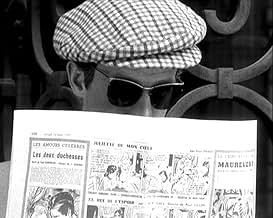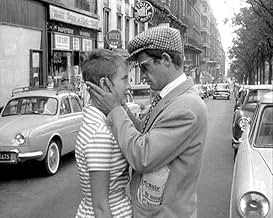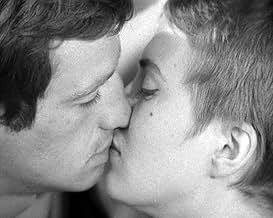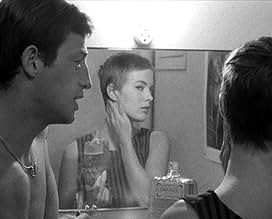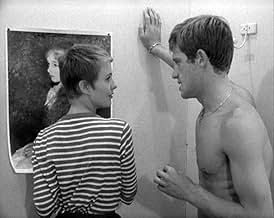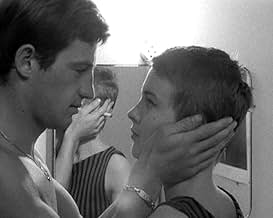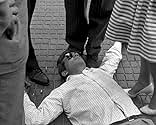À bout de souffle
- 1960
- Tous publics
- 1h 30min
NOTE IMDb
7,7/10
92 k
MA NOTE
Un petit escroc vole une voiture et assassine impulsivement un policier. Recherché par les autorités, il retrouve une étudiante américaine en journalisme et tente de la persuader de s'enfuir... Tout lireUn petit escroc vole une voiture et assassine impulsivement un policier. Recherché par les autorités, il retrouve une étudiante américaine en journalisme et tente de la persuader de s'enfuir avec lui en Italie.Un petit escroc vole une voiture et assassine impulsivement un policier. Recherché par les autorités, il retrouve une étudiante américaine en journalisme et tente de la persuader de s'enfuir avec lui en Italie.
- Réalisation
- Scénario
- Casting principal
- Nomination aux 1 BAFTA Award
- 5 victoires et 4 nominations au total
Jean Seberg
- Patricia Franchini
- (non crédité)
Richard Balducci
- Tolmatchoff
- (non crédité)
Daniel Boulanger
- Police Inspector Vital
- (non crédité)
Gérard Brach
- Photographer
- (non crédité)
Philippe de Broca
- A Journalist
- (non crédité)
José Bénazéraf
- Man in a White Car
- (non crédité)
Jean Domarchi
- A Drunk
- (non crédité)
Jean Douchet
- A Journalist
- (non crédité)
Liliane Dreyfus
- Liliane
- (non crédité)
- …
Michel Fabre
- Police Inspector #2
- (non crédité)
Jean-Luc Godard
- The Snitch
- (non crédité)
Roger Hanin
- Carl Zubart
- (non crédité)
Henri-Jacques Huet
- Antonio Berrutti
- (non crédité)
Raymond Huntley
- A Journalist
- (non crédité)
André S. Labarthe
- Journalist at Orly
- (non crédité)
Avis à la une
Together with François Truffaut's "The 400 Blows" (one of my favorites), Jean-Luc Godard's "Breathless" is considered the defining, instigating film of the French New Wave. It's more ironic and detached, less emotionally accessible than "The 400 Blows," and its technical innovations like jump cuts are perhaps even more surprising. For these reasons, I found "Breathless" easier to admire than to lovethough by the end I grew to enjoy its too-cool- for-(film)-school tone.
Ironically, the pace of this movie isn't "breathless" at all. It begins abruptly and takes a while to get going: Michel (Jean-Paul Belmondo), a character we barely know, drives a stolen car around, talks at the camera, and shoots a police officer who has tried to pull him over. Then he goes to Paris and tries to borrow money from some friends, while the police-shooting plot goes undeveloped. I only became fully engaged with the introduction of Patricia (Jean Seberg), a young American who sells newspapers on the Champs-Elysees. The relationship between Michel and Patricia is the heart of the film, especially a 25-minute-long scene in Patricia's apartment where the characters smoke, flirt, and laze around in bed, though nothing really happens. That's where I really started to admire "Breathless," because I was so captivated by a scene that, on paper, doesn't sound all that captivating.
Eventually the police catch onto Michel and launch a manhunt, but this doesn't really ratchet up the suspense. Instead, Michel is (or at least, Michel acts) aimless and nonchalant about the whole thingthis is not a typical "man on the run" movie. The cool jazz score adds to the hip, laid-back tone.
Since I didn't care for the movie too much until the scenes between Michel and Patricia, I believe a lot of the credit for the film's success has to go to the charismatic performances of Belmondo and Seberg. Belmondo, with a perpetual cigarette dangling from the corner of his mouth, is the archetypal cocky criminal who models himself after Humphrey Bogart (there's a great scene where he sees some Bogart photos and gets a vulnerable look in his eyes, as though saying "I'll never be as cool as this"). Seberg plays Patricia as a confused girl who is delighted by the attention she gets as an American in France.
It's easy to see why "Breathless" was so influentialthe jump cuts, the ragged style perfectly match this story about amoral, aimless youth. Definitely a movie that expanded the range of stories the cinema can tell, and perhaps a major precursor to youth-oriented '60s culture. Nearly fifty years later, it still seems "hip," and still challenges our expectations of how movies should behave.
Ironically, the pace of this movie isn't "breathless" at all. It begins abruptly and takes a while to get going: Michel (Jean-Paul Belmondo), a character we barely know, drives a stolen car around, talks at the camera, and shoots a police officer who has tried to pull him over. Then he goes to Paris and tries to borrow money from some friends, while the police-shooting plot goes undeveloped. I only became fully engaged with the introduction of Patricia (Jean Seberg), a young American who sells newspapers on the Champs-Elysees. The relationship between Michel and Patricia is the heart of the film, especially a 25-minute-long scene in Patricia's apartment where the characters smoke, flirt, and laze around in bed, though nothing really happens. That's where I really started to admire "Breathless," because I was so captivated by a scene that, on paper, doesn't sound all that captivating.
Eventually the police catch onto Michel and launch a manhunt, but this doesn't really ratchet up the suspense. Instead, Michel is (or at least, Michel acts) aimless and nonchalant about the whole thingthis is not a typical "man on the run" movie. The cool jazz score adds to the hip, laid-back tone.
Since I didn't care for the movie too much until the scenes between Michel and Patricia, I believe a lot of the credit for the film's success has to go to the charismatic performances of Belmondo and Seberg. Belmondo, with a perpetual cigarette dangling from the corner of his mouth, is the archetypal cocky criminal who models himself after Humphrey Bogart (there's a great scene where he sees some Bogart photos and gets a vulnerable look in his eyes, as though saying "I'll never be as cool as this"). Seberg plays Patricia as a confused girl who is delighted by the attention she gets as an American in France.
It's easy to see why "Breathless" was so influentialthe jump cuts, the ragged style perfectly match this story about amoral, aimless youth. Definitely a movie that expanded the range of stories the cinema can tell, and perhaps a major precursor to youth-oriented '60s culture. Nearly fifty years later, it still seems "hip," and still challenges our expectations of how movies should behave.
Watching Jean-Luc Godard's massively influential, unintentional-classic Breathless and discussing Jean-Luc Godard's massively influential, unintentional-classic Breathless are two totally different things. For one, the latter is more fun the other and, two, discussing the film almost instantly allows for quality, intelligent discussion of cinema to ring. There are certain cinephiles that take Godard himself more seriously than they take any other director who has ever lived. Just when you thought Stanley Kubrick-fanatical elitism was out of control, spend about ten minutes, as an exercise, scouring the internet for French New Wave forums and in-depth analysis of the Godardian methods and you may be surprised at what you find.
I'm only stating this because around a year and a half ago, I began my sporadic voyage into the depths of Godard with his most recent picture, at the time, Film Socialisme, which I found to be an assault on every conceivable sense and not in a particularly good way. The film was choppy, disjointed, messy, just about as incomprehensible as it could be, and trying to find justifications or analyses online proved ineffective. All and all, it's a film I just want to forget and I didn't care to dive into Godard much after that endeavor. I now realize that a decent part of the blame is on me for choosing perhaps the wrong film to begin my Godardian journey with. I emerge from seeing Breathless (known by its French title as À bout de soufflé) with a more of a positive reaction. This is a bravely-structured and maturely handled annihilation to every cinematic convention prior to its 1960 release down with class and impenetrable style on part of Godard.
The story - even though it is relatively the least of our concerns - follows Michel (Jean-Paul Belmondo), who is trying to emulate the characteristics possessed by Humphrey Bogart during the particular 40s/50s era of menacing American crime dramas that billed him as the lead actor. One day, feeling intimidated and a perhaps a little adventurous, Michel shoots a police officer who has been tailing him and now must deal with being broke and on the run from the cops. His only companion is Patricia (Jean Seberg), an American journalist getting by in life by selling newspapers in downtown Paris. The two desperately skim through their options trying to hide from the police, one of which is skipping town and going all the way to Italy as fugitives.
I say the story is the least of our concerns because there is simply not much to it. After all, Breathless is an aesthetic breakthrough rather than a narrative one. Godard employs dangerously subversive jump cuts - where the camera cuts to another shot within the same frame creating a breach in continuity - along with rapid-fire, quick shots and lengthy dialog scenes. All of this broke French cinema convention, which, prior to this, was consistently polished and very elegant. Godard invited in a rebellious messiness to the picture, almost like the guy coming into a neatly-organized room and rustling all the papers and files to not only create a stir but to do something different, something completely new.
It's almost shortchanging to simply say that I have immense respect for Godard seeing as in 1960, a time when social change and civil unrest amongst adolescents and twentysomethings seemed to be so prevalent in many different places, he ushered in a new way of doing things cinematically and created a stylistically bold film because of it. He even threw in the element of using a hand-held camera, an unheard of practice during this particular time. I think I would also be in line to compare Breathless to Bonnie and Clyde, a film that would enter the picture seven years later in American studios that would simultaneous shock and stimulate audiences everywhere.
Godard's films have a unique power after you watch them. For example, it has been about four days since I sat down to watch Breathless and since watching it - and now writing a medium-length analysis of it - I have a strong, biting urge to watch more of Godard's films. His films have the kind of impact where you just want to talk about them and talk about their impact in great length; which, once more, brings me to the point that watching the films is actually the weaker part compared to discussing them.
Starring: Jean-Paul Belmondo and Jean Seberg. Directed by: Jean-Luc Godard.
I'm only stating this because around a year and a half ago, I began my sporadic voyage into the depths of Godard with his most recent picture, at the time, Film Socialisme, which I found to be an assault on every conceivable sense and not in a particularly good way. The film was choppy, disjointed, messy, just about as incomprehensible as it could be, and trying to find justifications or analyses online proved ineffective. All and all, it's a film I just want to forget and I didn't care to dive into Godard much after that endeavor. I now realize that a decent part of the blame is on me for choosing perhaps the wrong film to begin my Godardian journey with. I emerge from seeing Breathless (known by its French title as À bout de soufflé) with a more of a positive reaction. This is a bravely-structured and maturely handled annihilation to every cinematic convention prior to its 1960 release down with class and impenetrable style on part of Godard.
The story - even though it is relatively the least of our concerns - follows Michel (Jean-Paul Belmondo), who is trying to emulate the characteristics possessed by Humphrey Bogart during the particular 40s/50s era of menacing American crime dramas that billed him as the lead actor. One day, feeling intimidated and a perhaps a little adventurous, Michel shoots a police officer who has been tailing him and now must deal with being broke and on the run from the cops. His only companion is Patricia (Jean Seberg), an American journalist getting by in life by selling newspapers in downtown Paris. The two desperately skim through their options trying to hide from the police, one of which is skipping town and going all the way to Italy as fugitives.
I say the story is the least of our concerns because there is simply not much to it. After all, Breathless is an aesthetic breakthrough rather than a narrative one. Godard employs dangerously subversive jump cuts - where the camera cuts to another shot within the same frame creating a breach in continuity - along with rapid-fire, quick shots and lengthy dialog scenes. All of this broke French cinema convention, which, prior to this, was consistently polished and very elegant. Godard invited in a rebellious messiness to the picture, almost like the guy coming into a neatly-organized room and rustling all the papers and files to not only create a stir but to do something different, something completely new.
It's almost shortchanging to simply say that I have immense respect for Godard seeing as in 1960, a time when social change and civil unrest amongst adolescents and twentysomethings seemed to be so prevalent in many different places, he ushered in a new way of doing things cinematically and created a stylistically bold film because of it. He even threw in the element of using a hand-held camera, an unheard of practice during this particular time. I think I would also be in line to compare Breathless to Bonnie and Clyde, a film that would enter the picture seven years later in American studios that would simultaneous shock and stimulate audiences everywhere.
Godard's films have a unique power after you watch them. For example, it has been about four days since I sat down to watch Breathless and since watching it - and now writing a medium-length analysis of it - I have a strong, biting urge to watch more of Godard's films. His films have the kind of impact where you just want to talk about them and talk about their impact in great length; which, once more, brings me to the point that watching the films is actually the weaker part compared to discussing them.
Starring: Jean-Paul Belmondo and Jean Seberg. Directed by: Jean-Luc Godard.
I finally did it. I finished watching À bout de souffle. I kept putting it off because I usually have problem when everybody tells me that such and such film is the epitome of its era or it breaks all the rules, starts the revolution, and reinvents the cinema. That's why, probably, I cannot like Citizen Kane - try to watch the arguably best film ever made - you will be under a lot of pressure.
Well, À bout de souffle does not put you under the pressure, it takes you for a ride, and you follow for 90 minutes its incredibly young characters, common crook (Jean-Paul Belmondo) and his American free-spirited girlfriend (Jean Seberg) on their journey on the streets of 1960-th Paris along with Raoul Coutard's legendary camera. I am not going to tell here how great the camera work was, how fantastic the music score and the views of Paris were - the fans of the film know that already. They also know about the beginning of French New Wave, and how it influenced the future cinema. I just want to say that the movie was made over forty years ago - the smoking was cool back then, and Belmondo made smoking look very sexy. Belmondo fascinates me in this film. I've seen him in a lot of later movies - he's always been good (I recommend Le Magnifique, 1973 and Le Professionnel,1981 ) - but in À bout de souffle he is not just good - he is embodiment of cool, his face changes its expression every moment, you can not take your eyes off him. Is it me or he does remind the very young Mick Jagger - not commonly handsome but irresistible and sexy? He and young (she was 21 at the time) Jean Seaborg made one of the best screen couples ever. My favorite scenes:
Michel drives the stolen car in the beginning of the film, and he starts to talk to us, the audience. The day is nice, the sun is shining, and the life is beautiful...
Michel and Patricia drive in the convertible. The wind plays with her short hair. We only see the back of her head and her neck. Michel tells her that he loves the girl with a beautiful neck, wrists, knees, but she is a chicken...
Patricia comes to the hotel to find Michel in her bed. They start talking about nothing and about very serious things. They smoke, she tries to find a good place for her new poster, and he wants to sleep with her. In the end of the scene, his face, he looks at her - there is love in that look...
There is more - I am sure everyone who saw it has his/her favorite scenes.
Well, À bout de souffle does not put you under the pressure, it takes you for a ride, and you follow for 90 minutes its incredibly young characters, common crook (Jean-Paul Belmondo) and his American free-spirited girlfriend (Jean Seberg) on their journey on the streets of 1960-th Paris along with Raoul Coutard's legendary camera. I am not going to tell here how great the camera work was, how fantastic the music score and the views of Paris were - the fans of the film know that already. They also know about the beginning of French New Wave, and how it influenced the future cinema. I just want to say that the movie was made over forty years ago - the smoking was cool back then, and Belmondo made smoking look very sexy. Belmondo fascinates me in this film. I've seen him in a lot of later movies - he's always been good (I recommend Le Magnifique, 1973 and Le Professionnel,1981 ) - but in À bout de souffle he is not just good - he is embodiment of cool, his face changes its expression every moment, you can not take your eyes off him. Is it me or he does remind the very young Mick Jagger - not commonly handsome but irresistible and sexy? He and young (she was 21 at the time) Jean Seaborg made one of the best screen couples ever. My favorite scenes:
Michel drives the stolen car in the beginning of the film, and he starts to talk to us, the audience. The day is nice, the sun is shining, and the life is beautiful...
Michel and Patricia drive in the convertible. The wind plays with her short hair. We only see the back of her head and her neck. Michel tells her that he loves the girl with a beautiful neck, wrists, knees, but she is a chicken...
Patricia comes to the hotel to find Michel in her bed. They start talking about nothing and about very serious things. They smoke, she tries to find a good place for her new poster, and he wants to sleep with her. In the end of the scene, his face, he looks at her - there is love in that look...
There is more - I am sure everyone who saw it has his/her favorite scenes.
Jean-Luc Godard intended to shake the delicate world of cinema, that much is obvious. But did he intend to reinvent it? Whether it was his intention or not isn't the point, the point is this; he did. Jean-Luc Godard, and Francois Truffuat are the undisputed fathers of the French New Wave. Some cinephiles or historians may feel like pointing elsewhere, to Jean Renoir for example, protesting that he is truly the father of the French New Wave, I disagree entirely. The French New Wave was a product of the kindred spirits and talents of Godard and Truffaut. And no other film represents the French New Wave more coherently than Jean-Luc Godard's dazzling 1960 picture, 'Breathless'. Unorthodox and uninhibited. Raw and experimental. Godard broke every rule in the book, disavowed the laws of cinema, and scribed a new rule book, one where the pages are blank, and possibilities are endless. The story is so simple I can summarize the entire film in half of a sentence, but I refuse to give you or Godard the satisfaction. What counts in Breathless is not the story, but how the story is told. The very definition of 'cool', the film is robust in creativity, and exuberant in its flaws, and passionate about its reckless behavior. Self aware and rebellious. If there was no breathless, there would have been no Tarantino, if there was no French New Wave, the streak of genius that ran through the nineties and 2000s wouldn't have existed. Before Breathless, it was believed that films took money, that you had to find yourself in a place of authority to make a film. Breathless broke this misconception. Breathless makes you want to run outside and make the film of your life. Breathless made that possible, Breathless made the amateur the auteur, Breathless reinvented the face of the cinema, and made you believe that could too. All you need is a girl and gun.
This is the one that started it all kids, the daddy of post-modern cinema. MTV jump cuts, fractured soundtrack and images aplenty
Self reflexive to the point that it not only acknowledges its own existence, it revels in it.
All style and no substance is considered a bad thing today, unless its Tarantino. Well, if it wasn't for Godard, chances are there would be no QT.
All the characters and images, and dialogue and sets are constructed from all aspects of life - Michel is a Bogart collage. Patricia apes everything she sees, from her Interviewee's facial gestures to Michel's own.
Don't let all this technical mumbo fool you, I did my thesis on Godard and would happily bore the ass off you with a lecture in great detail about this film, but the fact is, it's a stormer.
Grips you by the throat and shakes the hell out of you, and it doesn't let go until the final breath.
Fantastically, artistically magnificent. If Godard wanted to make his debut picture to show how well he understood American ideals and the history of cinema, he couldn't have made a better picture.
Top stuff French guy.
Self reflexive to the point that it not only acknowledges its own existence, it revels in it.
All style and no substance is considered a bad thing today, unless its Tarantino. Well, if it wasn't for Godard, chances are there would be no QT.
All the characters and images, and dialogue and sets are constructed from all aspects of life - Michel is a Bogart collage. Patricia apes everything she sees, from her Interviewee's facial gestures to Michel's own.
Don't let all this technical mumbo fool you, I did my thesis on Godard and would happily bore the ass off you with a lecture in great detail about this film, but the fact is, it's a stormer.
Grips you by the throat and shakes the hell out of you, and it doesn't let go until the final breath.
Fantastically, artistically magnificent. If Godard wanted to make his debut picture to show how well he understood American ideals and the history of cinema, he couldn't have made a better picture.
Top stuff French guy.
Le saviez-vous
- AnecdotesDespite reports to the contrary, Jean-Luc Godard did not shoot the film without a script; however, he did not have a finished script at the beginning, instead writing scenes in the morning and filming them that day. See also Pierrot le fou (1965).
- GaffesDuring street shots, countless passersby look at Patricia and Michel and stare into the camera, revealing that the shots were made without filming barriers and simply used street pedestrians in place of extras.
- Citations
Patricia Franchini: What is your greatest ambition in life?
Parvulesco: To become immortal... and then die.
- ConnexionsEdited into Pariz pripada nama! (2016)
Meilleurs choix
Connectez-vous pour évaluer et suivre la liste de favoris afin de recevoir des recommandations personnalisées
Détails
- Date de sortie
- Pays d’origine
- Langues
- Aussi connu sous le nom de
- Sin aliento
- Lieux de tournage
- 11 rue Campagne Première, Paris 14, Paris, France(on location)
- Sociétés de production
- Voir plus de crédits d'entreprise sur IMDbPro
Box-office
- Budget
- 400 000 F (estimé)
- Montant brut aux États-Unis et au Canada
- 414 173 $US
- Week-end de sortie aux États-Unis et au Canada
- 32 424 $US
- 30 mai 2010
- Montant brut mondial
- 594 039 $US
- Durée1 heure 30 minutes
- Couleur
- Mixage
- Rapport de forme
- 1.37 : 1
Contribuer à cette page
Suggérer une modification ou ajouter du contenu manquant

Lacune principale
What is the streaming release date of À bout de souffle (1960) in Australia?
Répondre




